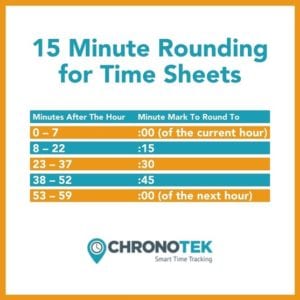Rounding Time Sheets using the 7-Minute Rule

Are you rounding your employees’ time sheets to make payroll easier, prevent early clock-ins, or even boost employee pay? It’s essential to accurately and legally round time clock punches to protect yourself and your business.
Do you want to ensure that your employees are always at the job site when clocking in?
Rounding Rules to Keep In Mind When Changing Timesheets
1 - Rounded Timesheets Cannot Benefit the Employer
Any time clock rounding adjustments made to the timesheet cannot be used by the employer to save money. For example, if an employer saw a timesheet with a start time of 8:03 and then rounded it to 8:15, the employer would save almost a quarter hour’s pay, even though the employee worked most of the quarter hour and should be compensated accordingly. Be careful with time card manipulation. The Fair Labor Standards Act (FLSA) requires that employers pay for all the time employees work.
2 - Follow the 7-Minute Rule
According to the Department of Labor, “Employee time from 1 to 7 minutes may be rounded down, and thus not counted as hours worked, but employee time from 8 to 14 minutes must be rounded up and counted as a quarter hour of work time.” If you want to double-check your timesheet rounding, the chart below breaks down how to round time sheets to the nearest 15-minute mark.
3 - You Cannot Round in Increments Greater Than 15 Minutes
While it’s common to round time sheets to the nearest quarter hour, employers can also round by the 1/10 of an hour (6 minutes) or by 5 minutes. Remember that employers cannot round in increments greater than 15 minutes.

Tired of Spending Time Manually Adjusting Each Employee Timesheet?
Skip the hassle of rounding employee hours with Chronotek Pro!
Employees can clock in anywhere and on any device. Chronotek Pro eliminates time card waste and helps you avoid problems with the FLSA. Pro is fantastic for your cleaning business, pool company, or security guard company.
Try for free for 14 days.
Conclusion
In conclusion, the practice of rounding time sheets using the 7-minute rule offers a practical and efficient method for businesses to simplify time tracking and payroll processing. By rounding employee clock-in and clock-out times to the nearest 7-minute increment, employers can streamline administrative tasks and minimize the impact of minor discrepancies in recorded time. This approach helps strike a balance between accuracy and efficiency, ensuring fair compensation for employees while reducing the burden of calculating exact minutes worked. However, it's essential for businesses to establish clear rounding policies and communicate them transparently with employees to maintain trust and compliance with labor regulations. Ultimately, adopting the 7-minute rule for rounding time sheets can contribute to smoother payroll operations and improved productivity in the workplace.
By embracing these solutions, you can simplify payroll processes, reduce administrative burdens, eliminate time theft, and minimize costly mistakes. Invest in an automated time clock system to save time and money while ensuring accurate and efficient payroll calculations. With the right tools and processes, you can focus on more strategic aspects of your business and watch your profits grow rather than worry about timecard rounding rules.





